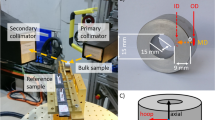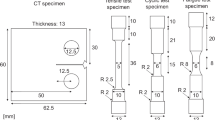Abstract
Background
Mechanical constitutive models of metals can be difficult to validate without loss of generality. Creep-induced stress relaxation in stainless steels is one such example: stress triaxiality may play a role in the deformation rate but is challenging to measure experimentally.
Objectives
We aimed to determine whether the accuracy of constitutive laws for multiaxial deformation, particularly creep deformation, can be verified by measuring the evolution of the complete stress tensor at a point within a structure.
Methods
Creep stress relaxation specimens of Type 316H stainless steel were exposed to 550 °C for different durations. We used time-of-flight neutron diffraction and finite element analysis to determine the complete stress tensors at points within the specimens, tracking their development as the residual stress field relaxed.
Results
Multiaxial stress relaxation of 316H occurs at 550 °C due to plasticity and creep, and can follow a non-proportional deformation path. In our measurements, over-determination of the elastic strain tensor using neutron diffraction was found to reduce stress uncertainty. A popular creep constitutive model for 316H, when used with finite element analysis, predicts slightly higher strain rates than were observed experimentally.
Conclusions
Sequential neutron diffraction stress measurements can be used to validate material constitutive laws in situations involving multiaxial deformation. This could be used to substantiate models of plasticity, viscoelasticity and creep. The RCC-MR primary/secondary creep law for 316H stainless steel is conservative for cases involving a complex initial stress field.
Graphical abstract














Similar content being viewed by others
Data Availability
Raw and analysed neutron diffraction data and finite element modelling results supporting the findings of this article can be accessed at: https://doi.org/10.5523/bris.rhg1bk2424a6262ecb9nouzp9.
References
Nonbøl E (1996) “Description of the Advanced Gas Cooled type of ractor (AGR),” Nordisk Kernesikkerhedsforskning (NKS)
Petkov MP, Hu J, Cocks ACF (2019) Self-consistent modelling of cyclic loading and relaxation in austenitic 316H stainless steel. Phil Mag 99(7):789–834
Hossain S, Truman CE, Smith DJ, Peng RL, Stuhr U (2007) A study of the generation and creep relaxation of triaxial residual stresses in stainless steel. Int J Solids Struct 44(9):3004–3020
Webster GA, Holdsworth SR, Loveday MS, Nikbin K, Perrin IJ, Purper H, Skelton RP, Spindler MW (2004) A Code of Practice for conducting notched bar creep tests and for interpreting the data. Fatigue Fract Eng Mater Struct 27(4):319–342
Hossain S, Truman CE, Smith DJ (2011) Generation of residual stress and plastic strain in a fracture mechanics specimen to study the formation of creep damage in type 316 stainless steel. Fatigue Fract Eng Mater Struct 34:654–666
R5 (2012) “Assessment Procedure for the High Temperature Response of Structures, Issue 3,” EDF Energy Nuclear Generation Ltd.
Spindler MW (1994) “The Multiaxial Creep of Austenitic Stainless Steels,” Nuclear Electric
Altenbach H (2003) Topical problems and applications of creep theory. Int Appl Mech 39(6):631–655
Ottosen NS, Ristinmaa M (2005) “Creep and Viscoplasticity,” in The Mechanics of Constitutive Modeling, Elsevier 387–421
Boyle JT, Spence J (1983) “Creep under multiaxial states of stress,” in Stress Analysis for Creep, Butterworths 39–62
Francis JA, Mazur W, Bhadeshia HKDH (2006) Type IV cracking in ferritic power plant steels. Mater Sci Technol 22(12):1387–1395
Perrin IJ, Hayhurst DR (1999) Continuum damage mechanics analyses of type IV creep failure in ferritic steel crossweld specimens. Int J Press Vessels Pip 76(9):599–617
Zolochevsky A, Voyiadjis GZ (2005) Theory of creep deformation with kinematic hardening for materials with different properties in tension and compression. Int J Plast 21(3):435–462
Cocks ACF, Ashby MF (1980) Intergranular fracture during power-law creep under multiaxial stresses. Metal Science 14:395–402
Spindler MW (2004) The multiaxial creep ductility of austenitic stainless steels. Fatigue Fract Eng Mater Struct 27(4):273–281
Boyle JT, Nakamura K (1987) The assessment of elastic follow-up in high temperature piping systems - overall survey and theoreticall aspects. Int J Press Vessels Pip 29:167–194
Sakanashi Y, Gungor S, Forsey AN, Bouchard PJ (2017) Measurement of creep deformation across welds in 316H stainless steel using Digital Image Correlation. Exp Mech 5:231–244
van Rooyen M, Becker TH (2018) High-temperature tensile property measurements using digital image correlation over a non-uniform temperature field. J Strain Anal Eng Des 53(3):117–129
Wang YQ, Coules HE, Truman CE, Smith DJ (2018) Effect of elastic follow-up and ageing on the creep of an austenitic stainless steel. Int J Solids Struct 135:219–232
Chen B (2011) “Effects of Thermo-Mechanical History on Creep Damage in 316H Austenitic Stainless Steel,” University of Bristol
Chen B, Smith DJ, Flewitt PE, Spindler MW (2011) Constitutive equations that describe creep stress relaxation for 316H stainless steel at 550 °C. Mater High Temp 28(3):155–164
Chen B, Hu JN, Wang YQ, Kabra S, Cocks ACF, Smith DJ, Flewitt PEJ (2015) Internal strains between grains during creep deformation of an austenitic stainless steel. J Mater Sci 50(17):5809–5816
Mehmanparast A, Davies CM, Dean DW, Nikbin K (2016) Effects of plastic pre-straining level on the creep deformation, crack initiation and growth behaviour of 316H stainless steel. Int J Press Vessels Pip 141:1–10
Li DF, O’Dowd NP, Davies CM, Nikbin KM (2010) A review of the effect of prior inelastic deformation on high temperaturemechanical response of engineering alloys. Int J Press Vessels Pip 87:531–542
Hamm CD (2011) “R66 AGR Materials data handbook,” British Energy Generation Ltd,.
Chen B, Hu JN, Flewitt PEJ, Smith DJ, Cocks ACF, Zhang SY (2014) Quantifying internal stress and internal resistance associated with thermal ageing and creep in a polycrystalline material. Acta Mater 67:207–219
Chaboche JL (1989) Constitutive equations for cyclic plasticity and cyclic viscoplasticity. Int J Plast 5(3):247–302
Chaboche JL (1986) Time-independent constitutive theories for cyclic plasticity. Int J Plast 2(2):149–188
Keinänen (1999) “Variation of Residual Stresses in Aged Components (VORSAC) Task 2.5.4 report: Isotropic-Kinematic Hardening Models,” VTT, VALC663
“RCC-MR (1985) Design and Construction Rules for Mechanical Components of FBR Nuclear Islands, Section 1, Sub-section Z, Technical Appendix A3.,” AFCEN
“RCC-MR (2007) Design and Construction Rules for Mechanical Components of FBR Nuclear Islands, Section 1, Sub-section Z, Technical Appendix A3.,” AFCEN
Wang YQ, Spindler MW, Truman CE, Smith DJ (2016) Critical analysis of the prediction of stress relaxation from forward creep of Type 316H austenitic stainless steel. Mater Des 95:656–668
Santisteban JR, Daymond MR, James JA, Edwards L (2006) ENGIN-X: A third-generation neutron strain scanner. J Appl Crystallogr 39(6):812–825
Zhang SY, Evans A, Eren E, Chen B, Pavier M, Wang Y, Pierret S, Moat R, Mori B (2013) ENGIN-X - instrument for materials science and engineering research. Neutron News 24(3):22–26
Daymond MR, Bourke MAM, Dreele RBV, Clausen B, Lorentzen T (1997) Use of Rietveld refinement for elastic macrostrain determination and for evaluation of plastic strain history from diffraction spectra. J Appl Phys 82(4):1554–1562
Daymond MR (2004) The determination of a continuum mechanics equivalent elastic strainfrom the analysis of multiple diffraction peaks. J Appl Phys 96(8):4263–4272
James JA, Edwards L (2007) Application of robot kinematics methods to the simulation and control of neutron beam line positioning systems. Nucl Instrum Methods Phys Res, Sect A 571(3):709–718
Nneji SO, Zhang SY, Kabra S, Moat RJ, James JA (2016) Modelling and control of neutron and synchrotron beamline positioning systems. Nucl Inst Methods Phys Res A 813:123–131
Nneji SO (2017) “Development of a Robotic Positioning and Tracking System for a Research Laboratory,” The Open University
Larson AC, Dreele RBV (2004) “General Structure Analysis System (GSAS),” Los Alamos National Laboatory, LAUR 86–748
Withers PJ, Preuss M, Steuwer A, Pang JWL (2007) Methods for obtaining the strain-free lattice parameter when using diffraction to determine residual stress. J Appl Crystallogr 40(5):891–904
Holden TM (2013) “Neutron Diffraction,” in Practical Residual Stress Measurement Methods, 1st ed., G. S. Schajer, Ed. Wiley
Noyan IC, Cohen JB (1987) Residual stress - measurement by diffraction and interpretation. Springer
Winholtz (2003) “Characterization of macrostress,” in Analysis of residual stress by diffraction using neutron and synchrotron radiation, M. E. Fitzpatrick and A. Lodini, Eds. Taylor and Francis 60–77
Coules HE, Horne GCM, Kabra S, Colegrove P, Smith DJ (2017) Three-dimensional mapping of the residual stress field in a locally rolled aluminium alloy specimen. J Manuf Process 26:240–251
Priesmeyer HG, Schroder J (1991) “Strain tensor determination using neutron diffraction,” in Shot peening - Theory and application, J. S. Eckersey and J. Champaigne, Eds. IITT-International, 95–100
Robinson JS, Hughes DJ, Truman CE (2011) Confirmation of principal residual stress directions in rectilinear components by neutron diffraction. Strain 47(Suppl. 2):36–42
Wimpory RC, Ohms C, Hofmann M, Schneider R, Youtsos AG (2009) Statistical analysis of residual stress determinations using neutron diffraction. Int J Press Vessels Pip 86(1):48–62
Wimpory RC, Ohms C, Hofmann M, Schneider R, Youtsos AG (2009) Corrigendum to "Statistical analysis of residual stress determinations using neutron diffraction. Int J Press Vessels Pip 86(10):721
Noyan IC, Bunn JR, Tippett MK, Payzant EA, Clausen B, Brown DW (2020) Experimental determination of precision, resolution, accuracy and trueness of time-of-flight neutron diffraction strain measurements. J Appl Crystallogr 53:494–511
Douglas J, Spindler M, Dennis R (2007) “Development of an advanced creep model for Type 316 stainless steel,” in Proceedings of the 8th International Conference on Creep and Fatigue at Elevated Temperatures (CREEP8) 26152
Acknowledgements
This work was funded by the UK Engineering and Physical Sciences Research Council under grant no. EP/M019446/1 “Advanced structural analysis for the UK nuclear renaissance”, with YW’s contribution funded under EP/T012250/1. Specimen material was supplied by EDF Energy. Access to the ISIS Pulsed Neutron and Muon Source was provided by the Science and Technology Facilities Council under allocation no. RB1610043.
Author information
Authors and Affiliations
Corresponding author
Ethics declarations
Ethical Approval
No animal or human subjects were used in this research.
Conflict of Interest
The authors declare no conflicts of interest.
Additional information
Publisher's Note
Springer Nature remains neutral with regard to jurisdictional claims in published maps and institutional affiliations.
Highlights
• Neutron diffraction enables measurement of complete stress tensors inside homogeneous stainless steel specimens subject to high-temperature stress relaxation.
• Material deformation processes which cause a non-proportional change in multiaxial stress can be studied.
• Comparison with finite element analysis confirms that a widely-used creep rate law is conservative for multiaxial stressing.
• Reduction in stress tensor uncertainty is achievable using over-determined neutron diffraction measurements.
Rights and permissions
About this article
Cite this article
Coules, H.E., Nneji, S.O., James, J.A. et al. Full-tensor Measurement of Multiaxial Creep Stress Relaxation in Type 316H Stainless Steel. Exp Mech 62, 19–33 (2022). https://doi.org/10.1007/s11340-021-00755-0
Received:
Accepted:
Published:
Issue Date:
DOI: https://doi.org/10.1007/s11340-021-00755-0




